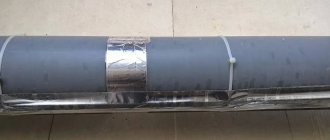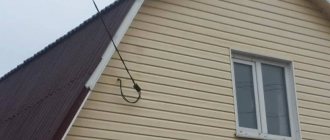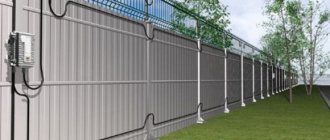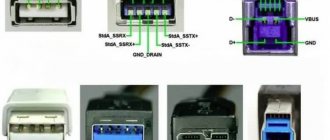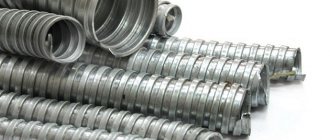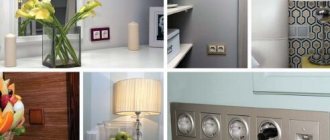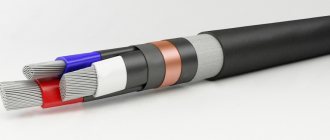Lightweight but durable plastic plumbing fixtures have greatly simplified the installation of many appliances. In particular, the corrugation for the toilet allows you to connect the outlet of this type of plumbing to the sewer outlet much faster and without much difficulty.
Do you want to install the corrugation yourself? We will tell you how to do this - the article discusses the procedure for installing corrugations and options for connecting toilets with different types of outlet. Installation tips and recommendations for choosing the best corrugation are also provided.
Thanks to a detailed analysis of important nuances, the connection procedure is quite accessible even to a non-professional.
Installation of corrugated pipes
For external (open) installation, special plastic clips are used to secure the corrugations for cables and wires, which are selected to match the outer diameter of the pipe. The clips are attached every 20-30 cm with self-tapping screws or dowels, depending on the type of wall. The corrugation for the kbaley is inserted into the installed clips and pressed until it clicks. When installed in a groove, it is secured with plastic ties or dowel ties. You can also use homemade fasteners - strips of tin with nails or screws in the middle.
When developing a route, the following recommendations should be taken into account. They assume that the route should be without sharp turns so that, if necessary, a new piece of cable can be tightened. Because:
- The maximum possible length of the section is 20-25 meters. Provided that the track has no more than 4 turns.
- Turns should not be located next to each other. The distance between them is at least 4-5 meters. If there is a need to make turns nearby, it is better to place a junction box or inspection hatch near them.
- The rotation angle is at least 90°, the radius is larger, the better.
- If the routes for electrical wiring and low-current cables and wires run side by side, the minimum distance for laying two corrugated sleeves is 200 mm. They can only intersect at right angles.
These rules apply to the development of routes for ground (suspension) and underground cable laying, among other things. If the route is long, and you want to be able to re-tighten the cable “if something happens” without replacing the corrugation, design the route taking these rules into account.
Corrugated wiring installation
When installing wiring in a house or apartment, pieces of corrugation are secured between distribution boxes, from them to switches/sockets, and to lighting fixtures. The sections here are usually small, straight, with a maximum of one or two turns. So there are no problems with cable tightening.
If you need to tighten several conductors into a cable corrugation, they are folded and secured along the entire length with adhesive tape or electrical tape in increments of 30-50 cm (depending on the rigidity). Hard insulation is stripped off 10-15 cm from one edge, the wires are twisted into a common bundle, and a loop is formed from it (also secure the loop with tape or tape). If the rope turns out to be too thick, you can form loops separately, just stretch the twine through everything. A cable is tied to this loop, and then they begin to pull it from the opposite side, pulling the sheath over the cables. In this case, you must pull without jerking, smoothly, so as not to damage the cable or cable.
How to pull a cable into a corrugation
During installation, be careful not to let the broach slip out. To be sure, you can secure the cable with a piece of tape. There are two installation approaches:
- First secure the corrugation, then tighten the cable or wires into the finished piece.
- First stretch the cable, then install it.
The first method is good when installing internal wiring, where the distances are small - from box to box, from box to outlet, etc. The second method is more suitable when installing long sections.
Features of open installation on the street
When laying wiring outdoors, it is usually suspended on a cable. For outdoor use, a metal one made of stainless steel is suitable, or better yet a metal-polymer corrugation for the cable, as well as a plastic one made of polyamide (black or blue). All these materials are UV resistant and remain flexible at sub-zero temperatures.
Although this is a cheap method, it is not the best, since the ties will burst
During installation, the cable pulled into the corrugation is suspended on a cable. The cheapest fastening is ordinary plastic ties. There are also special hangers.
Features of repair of fan systems
Installation of the internal sewerage system is carried out “in the socket”. This greatly simplifies the process of installing and dismantling all pipeline elements.
Repair work is necessary when there is physical damage to a drain or sewer pipe. Due to the excellent rigidity (pipe bending resistance is 80 MPa) and the long service life of the plastic (up to 60 years), there is a low probability of physical damage to the pipes.
When repairing sewer pipes, the technician must take into account the following rules:
- the end of the drain pipe is positioned in such a way as to ensure effective dispersion of unpleasant odors;
- the diameter of the pipe must be the same or larger than the riser on which the installation is being carried out;
- lay the pipe in warm rooms, and complete the installation in a cold zone, since the temperature difference provokes a pressure difference in different sections of the pipe.
Repair work involves connecting a waste pipe to a sewer riser. At the same time, vacuum valves are installed on other risers - rubber seals equipped with springs.
Replacement and repair of drain pipes must be carried out according to design documentation, taking into account the rules for installing risers in the sewer system
During operation, the sewer system creates a vacuum in the valve, as a result of which it opens and sucks air from the room. After stabilizing the pressure in the riser, a special spring automatically closes the check valve, preventing the unpleasant odor from escaping into the atmosphere.
Corrugation for wires: design and materials
Corrugated pipe for cable is used for installation of all kinds of lines, as well as for various wiring options: disguised, underground and external. They differ in their design, technology and raw materials.
The following types of materials can be used:
HDPE is a flexible wire;
Application of HDPE material
- polyvinyl chloride is a self-extinguishing type of raw material;
- pnd is used for hidden lines. It is laid in concrete structures or bricks;
- polypropylene is a plastic line that is used to install the cable;
- polyamide provides good waterproofing.
Structure of a polyamide product
If the wiring is laid over flammable types of material, then heat-resistant metal corrugation is used. Pipes can have different designs. In the single-layer version, the main has one wall between the outer and inner surfaces. A two-layer product has an inner layer that is placed in a protective casing.
Corrugated wires are in demand due to many advantages:
- long service life;
- does not allow moisture to pass through;
- fire resistance;
- increased resistance to various types of load;
- does not corrode;
- light weight.
Electric wires
Types of corrugated pipes by material of manufacture
Today, corrugated pipes are available on the market in a variety of materials, each of which is suitable for a particular situation. There are pipes made of PVC, PPR, PPR and stainless steel. Let's look at each in more detail.
PVC (polyvinyl chloride)
PPR (polypropylene)
HDPE (low density polyethylene)
Stainless steel
If you need to install wiring under a suspended ceiling on brickwork or concrete, take PVC corrugation - it is inexpensive and easy to install. For wiring over flammable materials such as wood, it is better to take an armored sleeve made of stainless steel or PVC and PPR, but with an additional backing. For outdoor installation, we recommend using a corrugated HDPE tube in black or orange, or using polypropylene products.
Application areas of metal corrugation
The main property of metal corrugation is to protect cables and wires from mechanical damage. The PVC insulated pipe additionally protects the conductors laid inside from dust and aggressive media: vapors, liquids and gases. This is the determining factor for its use in industrial enterprises.
In domestic premises, metal corrugation is used when laying cable lines over combustible structures. These are electrical wiring above suspended ceilings, in wooden houses, and outbuildings.
When a cable route crosses pipelines and lays them parallel, the cables are also protected with metal corrugation
This is of particular importance in the vicinity of gas pipelines and heating pipes that have elevated temperatures.
Additional protection of cables is also required when laying in the ground or concrete screed. Laying electrical wiring in a wall or concrete allows it to be replaced if necessary. However, for this, the track must have a minimum number of turns, and there must be junction boxes at the minimum possible distance.
Kinds
Corrugations for wires are available in several dozen types. The articles of this special product differ in color, material of manufacture, diameter, load-bearing capacity, and wall thickness. Let's look at the types of corrugated pipes:
By material
- Polyvinyl chloride (PVC). Used as non-flammable and inexpensive cable protection products that must be located away from exposure to sunlight, water and ultraviolet radiation.
- Metal (metal hoses). Protect from mechanical damage, fires, corrosive and other active substances.
- Polyethylene, polypropylene (PPR). They can be intended for installation under conditions of high (HPE) or low (HDPE) pressure, withstand temperature influences from – 40 ° C to + 45 ° C, as well as exposure to acids, alkalis, ultraviolet rays and oils (PPR pipes are self-extinguishing and usually are painted gray during manufacturing, HDPE – orange or black).
Polyethylene corrugation Source elektro-svitidla.com
In terms of resistance to external influences
- Lightweight (wall thickness up to 320 N/5 cm², flexible, cannot withstand heavy loads) are laid in ceiling and wall plasterboard structures.
- Medium ones (wall thickness up to 750 N/5 cm²) can be placed in the grooves of room walls.
- Heavy (wall thickness up to 1250 N/5 cm², are inflexible) can withstand installation in concrete screeds, withstand exposure to moisture, dust and dirt.
- Reinforced super-heavy (the thickness of the walls of the metal corrugation for electrical wiring is more than 1250 N/5 cm², it consists of metal wires twisted in a spiral, covered with a plastic sheath) intended for installation outdoors or underground.
By number of layers
- Single-layer (may have different thicknesses).
- Double-layer (have two walls at once).
Metal corrugation, in turn, is divided into several subspecies. It can be made from stainless or galvanized steel; plastic or polymer material is used as a coating. Metal-polymer corrugated hose has the best user characteristics, as it maximally protects wires from water and dust.
This is interesting! Typically, red, blue and black polyethylene corrugated pipes are used for outdoor use and general purpose circuits, respectively, white ones are found in places where the Internet and electrical networks are laid, green ones are used for telephony, although this rule is not required to be observed.
Laying metal corrugation Source rusenergetics.ru
See also: Catalog of companies that specialize in electrical work of any complexity
The outer diameter of corrugated cable products can range from 16 mm to 87.5 mm, the inner diameter - from 5 mm to 78 mm. Also, the design of some corrugated pipes includes a probe that helps pull flexible wires through the sleeve.
According to GOST R IEC 61386, several types of corrugated hoses are distinguished: according to the degree of spread of the combustion process, and according to protection against corrosion. According to the rules of GOST 14254-2015, the degree of protection of corrugated pipes from penetration and exposure to solid particles and/or water is indicated according to the IP index. Corrugated highways are also divided into several types according to the temperature range at which they can be operated. When choosing a specific type of corrugation, a specialist must be guided by information about the use and location of the wiring being laid.
Laying in grooves Source uk-parkovaya.ru
For example, outdoors it is imperative to use a protected reinforced corrugated pipe, which resists the effects of mechanical, natural, and temperature factors and has an IP rating corresponding to the expected load.
Size
The thickness of the corrugated cable determines the number and thickness of wires that can be laid through such a protective sleeve. When a corrugated pipe is sold, it is marked in which the first number indicates the outer diameter, the second - the wall thickness. The diameter of the cable corrugation is indicated in the table:
This is how the thickness of the corrugation is determined (table, part 1) Source infocable.by
This is how the thickness of the corrugation is determined (table, part 2) Source infocable.by
Metal corrugations for cables, price and application
The metal model consists of zinc or steel strip.
This design will allow you to withstand the most difficult loads with a small thickness of metal walls. With such indicators, the model has a very flexible body (bends like a hose).
Application of the design
In what cases is a metal model used:
- The metal structure is used to protect against severe mechanical damage (for example, load from the ground or screed).
- Often used in buildings that burn quickly (for example, a wooden house, suspended ceiling and other similar structures).
- Where the pipeline and electricity intersect.
- In an aggressive environment.
- Also in places with the possibility of further replacement.
Note! To replace the wiring in the corrugation, you will need many junction boxes so that the broaching can be done in a straight line
Cost overview
In this section, we will analyze the average price of a booster compressor station with a diameter of 1.6 cm for different cities in Russia:
| Cities | Cost, rub. |
| Saint Petersburg | 601,96 |
| Chelyabinsk region | 596,00 |
| Ufa | 607,92 |
| Krasnoyarsk region | 569,00 |
| Krasnodar | 572,16 |
| Perm region | 584,08 |
| Novosibirsk | 625,80 |
| Ekaterinburg | 601,96 |
Why do you need a corrugated hose?
Installing electrical wiring is a responsible matter that does not tolerate mistakes. The safety of staying in electrified premises directly depends on its quality.
The benefits of civilization in the form of glowing light bulbs and numerous household appliances, by definition, cannot work without being connected to the power grid.
And any live electrical cable is a source of damaging current that is dangerous to humans.
It is recommended to use corrugated cables for electrical wires everywhere (for hidden and open installation methods, for installation outdoors and indoors). If this is not possible for aesthetic reasons, then it should be replaced with a decorative cable channel
The first protection against electric shock is the insulating braid of the cable itself. Regardless of the material used, it reliably protects a person from the current flowing through the veins.
However, insulation does not last long. These aluminum or copper wires can last 15–25 years, but the outer braid on them is often damaged within 3–4 years after the wiring is put into operation.
The service life of electrical wire insulation is greatly reduced due to:
- high humidity (outdoor or room);
- overheating under increased loads;
- ultraviolet radiation and other factors.
The result is a breakdown, short circuit, fire and electric shock to a person. To minimize risks, electricians lay wires in a corrugated sleeve.
On the one hand, it serves as an additional barrier between electric current and a person, and on the other hand, it serves as protection for the cable.
If the need arises to replace the old wire in the corrugation, it is simply pulled out of the sleeve, and a new one is inserted in its place - and it does not matter whether this channel is located under the finishing or in a concrete screed
A cable laid in a corrugated pipe receives protection from:
- compression and other mechanical damage;
- ultraviolet radiation and precipitation (when laying wires outdoors);
- exposure to moisture.
And the last thing is fire safety. All corrugated hoses for electrical cables are made of non-flammable or self-extinguishing materials.
This reduces the likelihood of exposure to an open flame on the wire inside the corrugation, and also prevents the spread of fire during short circuits and fires of the plastic cable braid.
How to calculate the diameter depending on the specific use of structures
The parameters of sewer pipes largely depend on where exactly they will be installed. To install the system in an apartment or private house with an average amount of plumbing equipment, a structure measuring 100 mm is sufficient.
What should be the diameter of sewer pipes in the kitchen? Designs of 40-50 mm in size are suitable for the sink. 50 mm is the optimal parameter for products for installation in the kitchen. Firstly, the shaped parts of the sink are designed for it. Such parameters allow you to achieve maximum compatibility of communications. Secondly, it provides high-quality drainage of waste from the kitchen sink.
In bathrooms, a sufficient pipe diameter is 50 mm. This is enough to provide the required throughput. The parameters for installing the structure under the washing machine depend on its technical characteristics. The dimensions of the drainage product should not be smaller than the dimensions of the drain hose of the washing equipment.
Typically, most plumbing fixtures are located in the kitchen. For a sink and sink, a 50 mm outlet will be sufficient. For a washing machine, 32 mm is enough. Dishwashing equipment in the kitchen will require a structure measuring at least 40 mm.
You can see which products are best installed for certain needs in the photo.
Additional recommendations
Knowing the required diameters of sewer pipes for a toilet, bathtub, and so on is not everything
It is also important to know information about the features of certain structures and the specifics of their installation:
- The internal parameters of cast iron structures gradually decrease due to deposits and silt formation;
- Plastic structures retain their internal parameters even after many years of use due to the smooth surface on which fat and other deposits do not accumulate;
- To install systems in a 5-story building, structures measuring 100 mm are used, for multi-story buildings - 150 mm.
You can supplement the information provided about the recommended parameters of sewer structures by viewing photos.
Rules for installing PVC pipes for electrical wiring with your own hands
Laying out an electrical network begins with a layout of sockets, automatic machines, lamps, switches, and connection points for stationary electrical equipment (stove, boiler, electric oven). All power supply lines must run either vertically or horizontally, at a distance of 20 cm from the ceiling, floor, door, and distribution boxes must be installed at branching points.
Regardless of the wiring installation method (behind a false wall, in grooves), there must be access to the boxes. Connecting wires is allowed only in junction boxes and under no circumstances inside the shell pipe.
When installing pipes for pouring into a screed or concrete wall, you must first securely secure the structure using metal clamps. When installing a pipeline in a groove in a brick wall, you can fix it with quick-setting plaster (alabaster) and then plaster it.
To install the pipe shell outdoors, metal clamps are used; inside the building, plastic clips are used.
During installation, any pipes must fit into the opening of boxes, sockets, switches; gaps between the box and the pipe are not allowed.
In damp rooms, outdoors and in the ground, sealed pipes are used for installing electrical wiring. At the joints of pipes and distribution boxes, special seals are used (you can additionally coat them with sealant, for example, silicone). When laying open communications in dry rooms, the use of seals is not necessary.
If the electrical wiring is installed near the heating system, then when crossing, the distance from the heating should be at least 5 cm, and if the pipes run parallel, then the distance should be at least 10 cm.
You cannot bend pipes with a small turning radius; when bending, you must comply with the standard radius and use a pipe bender or templates. There should be no cracks, folds, or creases at the bend site.
Required tools and materials
Tools required to perform work with corrugated hoses:
- Grinder with cutting disc.
- Hammer.
- Drill and screwdriver.
- Metal scissors.
- Construction knife.
Materials:
- Corrugated sleeve
- Clips or clamps.
- Dowels.
- Distribution boxes, boxes for sockets and switches.
- Electrical tape, scotch tape.
- Sealing gaskets, sealant.
- Perhaps a hard thin wire or a special broach.
Installation technology
The installation technology is quite simple:
- Cut the pipes or corrugation into pieces of the required length; when cutting the corrugation, you must ensure that the probe does not go inside the pipe.
- Securely attach the cable to the probe using tape or tape. The bent tip of the probe must be bitten off, otherwise when the cable is retracted it will damage the inner surface of the corrugation.
- Pull the cable into the tube. If several wires are pulled in, you need to tape them together several times with electrical tape.
- Mark the location of the cable in the casing and the places of fastenings.
- If necessary, punch a hole, secure the tube using clamps, clips, or alabaster. Fasteners must be installed at intervals of at least 50 cm and always near the boxes, at a distance of no more than 20 cm. The system can only be filled after the pipelines have been securely fastened.
- Mount boxes, tees, bends, connect to pipes, seal if necessary (install seals, lubricate with silicone).
Features of corrugated pipe installation
The corrugated pipe has very great flexibility - after installation it will sag slightly; it is necessary to frequently place clips or clamps. Do not tighten the corrugation too much during installation - this weakens its strength. When installing behind plasterboard or other facing materials, you cannot lay the corrugation obliquely - only vertically and horizontally. You can attach the corrugated hose to the frame structures for cladding. Do not lay corrugation through sharp corners on structures - it will quickly become damaged.
Why do you need corrugated wires?
Today, most often, corrugation for electrical wiring is used from PVC material or metal.
This will solve several issues at once:
- The wires will not be deformed.
- Protection from all external precipitation will be provided.
Such a part is important for protection against electric current, for example, during construction work.
Note! When building a house, the wiring is laid with special care, since any building shrinks. Corrugated pipe for electrical wiring acts as an additional protection factor
In what cases can corrugation not be used?
In cases where the design is not a strictly required part of the electrical wiring. There are cases when the cable is installed in grooves, after which plastering is carried out.
The design also does not occur if the electrical wire is pulled while external insulation work is being carried out.
Note! The wire is designed to withstand cold and humidity and has an increased level of strength.
Methods for protection
It is mandatory to use corrugated cables for wiring inside a wooden structure.
So:
- In some cases, the structure is replaced with PVC cable. But in terms of safety it is inferior to corrugated. At the same time, the cable is resistant to complex mechanical damage.
- For attic structures, it is best to use corrugated material or durable pipe.
- A cable is used for new wiring if there are no plans to renovate the premises.
- In a residential area, such a wire will not look beautiful due to its unaesthetic appearance.
Note! You can also do without corrugation in cases where reliable fixation and quality of insulation are ensured.
Which manufacturers are trustworthy?
Do not buy openly “no-name” corrugation, as practice has shown that the stated characteristics often do not correspond to reality. Of the manufacturers that deserve trust, we note the following:
- DKC;
- I.E.K.;
- EKF;
- KOPOS;
- ERA;
- Ekoplast;
- RUVINYL;
- NASHORN - so far only PVC corrugation is in stock.
Their components are of course more expensive than their Chinese counterparts, but the quality is many times better. Moreover, there are no problems buying in Russia.
Some more interesting things from the world of electrical engineering:
Laying electrical wiring in a metal corrugation
Installation of electrical wiring in corrugated pipes is divided into three stages:
- Pulling wires or cables into the corrugation
- Laying corrugated surfaces and inserting cables into panels and electrical installation equipment
- Connecting cables or wires
Before laying, it is necessary to measure the required length of the corrugated pipe and cable along the route and cut off the necessary pieces with a margin.
In order to successfully tighten the cable into the corrugation, you need to securely attach it to its wire conductor. For this:
- Cut the end of the cable to a distance of 3-5 cm;
- One core is selected, the rest are bitten off at the cutting boundaries;
- Wind the conductor wire turn to turn in the middle of the selected core. Then they bend it in this place. The remaining piece of the conductor, so that it does not cling to the corrugation from the inside, is either bitten off or cut off;
- Wrap the joint with electrical tape so that the cutting end does not create obstacles when tightening;
- The opposite end of the conductor is tied to the door handle, fence or any suitable object. The space in the room should be enough for the corrugation with the cable attached to it to be completely straightened;
- Straighten the metal cable and cable;
- They pull the corrugated pipe, putting it on the cable. The cable itself must be tensioned along with the corrugation. At this stage, depending on the length, the help of several people will be required.
There are many options for attaching a conductor to a cable. You can pierce the cable sheath with it, bend it and wrap the puncture site with electrical tape. When pulling several cables or drives into one corrugation at the same time, their ends are connected using their own cores or wire, and the conductor is hooked to the middle of the bundle.
The corrugated pipe is laid along brick and wooden walls using clips. For fastening to metal surfaces, staples are used: single-legged or double-legged. To fasten corrugations of a certain diameter, staples of the appropriate size are used.
The metal corrugation is attached to the surfaces at a distance that prevents it from sagging. The turning radii must correspond to the values permissible for the cable being laid.
Particular attention should be paid to the entry of wires and cables in a corrugated pipe into electrical equipment housings. Condensation should not accumulate inside the corrugation, which means its ends should be sealed
Therefore, when laying wiring outdoors or in industrial premises with aggressive or dusty environments, the end of the corrugation must be sealed.
To enter wires and cables into the housings of electrical panels and boxes using corrugation, special couplings are used: MVP (plastic) or MVC (zinc). Fittings are also produced for connecting metal hoses to each other and to metal pipes.
Couplings - the simplest option
This method is the simplest, but not everyone may like it. It is suitable for those who do not want to bother with pulling a cable through a long corrugated pipe or when repairing a damaged area. The bottom line is that the cable is pulled through relatively short pieces of corrugated pipe and special couplings. The joints are sealed.
PHOTO: dobrostroy.rf Couplings are a good option for those who don’t want to bother with pulling a long cable
